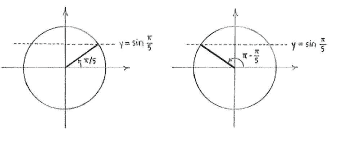Solution 4.4:3b
From Förberedande kurs i matematik 1
(Difference between revisions)
m |
|||
| (3 intermediate revisions not shown.) | |||
| Line 1: | Line 1: | ||
| - | + | We see directly that <math>x = \pi/5</math> is a solution to the equation, and using the unit circle we can also draw the conclusion that <math>x = \pi - \pi/5 = 4\pi/5</math> is the only other solution between <math>0</math> and <math>2\pi\,</math>. | |
| - | < | + | |
| - | + | ||
| - | [[ | + | [[Image:4_4_3_b.gif|center]] |
| + | |||
| + | We obtain all solutions to the equation when we add integer multiples of <math>2\pi\, </math>, | ||
| + | |||
| + | {{Displayed math||<math>x = \frac{\pi}{5} + 2n\pi\qquad\text{and}\qquad x = \frac{4\pi}{5} + 2n\pi\,,</math>}} | ||
| + | |||
| + | where ''n'' is an arbitrary integer. | ||
Current revision
We see directly that \displaystyle x = \pi/5 is a solution to the equation, and using the unit circle we can also draw the conclusion that \displaystyle x = \pi - \pi/5 = 4\pi/5 is the only other solution between \displaystyle 0 and \displaystyle 2\pi\,.
We obtain all solutions to the equation when we add integer multiples of \displaystyle 2\pi\, ,
| \displaystyle x = \frac{\pi}{5} + 2n\pi\qquad\text{and}\qquad x = \frac{4\pi}{5} + 2n\pi\,, |
where n is an arbitrary integer.

